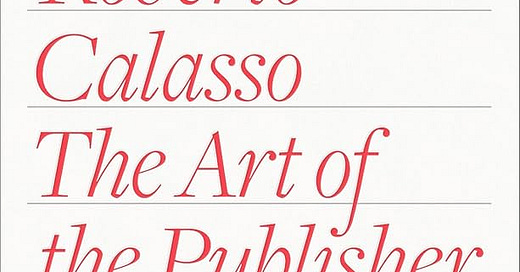The Publisher as a God, a Gardener, and a Madman
Review of Roberto Calasso's "The Art of the Publisher", Richard Dixon transl. (2015)
A publisher doesn’t just print books; he crafts a universe, each title fitting into a grander design. This isn’t corporate publishing, where books are products and readers are customers. It’s something older, deeper — closer to alchemy than industry.
"A true publisher is one who constructs a world."
Not a list. Not a brand. A world. Or, so insists Roberto Calasso.
Translated to English in 2015 by Richard Dixon, Roberto Calasso's The Art of the Publisher delivers a manifesto disguised as a memoir.
As the longtime head of Italian publishing house Adelphi Edizioni, Calasso speaks with the authority of someone who has spent decades curating not just books but a sensibility.
"Publishing houses are like novel characters. Each has its unmistakable personality, or lacks one."
In these collected essays, he makes a passionate case for publishing as a cultural practice that transcends mere commerce—a refreshing stance in an era of corporate consolidation and algorithmic recommendation engines.
A Lost Art in a Disposable World
Calasso isn't some ivory tower theorist. Since 1971, he has shaped Adelphi Edizioni into one of Europe's most distinctive publishing houses, and this practical experience informs every page.
"The publisher is first and foremost a form-giver."
Calasso insists that publishers serve as cultural navigators. A publisher's thoughtful selection and presentation of texts shapes societal conversation.
"We published Nietzsche when Marxism dominated intellectual conversation."
He challenges publishers to consider their list as a coherent body of work rather than a collection of random titles.
"A publishing house expresses itself first of all through what it publishes."
It’s an idea that feels almost utopian today, when the market is flooded with books designed to be consumed and forgotten. But Calasso isn’t nostalgic—he’s defiant.
"Books cannot be reduced to their content, extractable and abstractable. Books are objects that have their own aura."
He believes in the power of the book as an object, a relic, something that belongs in a lineage rather than on a bestseller list.
Where Calasso shines
Calasso makes you fall in love with the physical form of books. His detailed analysis of font choices, cover designs, and paper stocks reveals a publisher who understands that form and content are inseparable.
He passionately defends book covers as "the first irrevocable step toward the text," and typography as the "feature that most immediately defines a book's personality."
Some of the book's most captivating passages explore the mid-20th century golden age of publishing, when figures like Kurt Wolff, Peter Suhrkamp, and Giulio Einaudi transformed publishing houses into cultural institutions and intellectual movements.
"They were like laboratories where one experimented with ways of giving form to contemporary sensibility."
What makes The Art of the Publisher more than just nostalgic handwringing is Calasso's concrete example of resistance through quality.
Adelphi's success—both artistic and financial—offers a blueprint for publishers seeking to maintain independence while creating a distinctive cultural identity.
What might disappoint you
Calasso writes with the confidence of someone unconcerned with dumbing down complex ideas.
He meanders, he philosophizes, he assumes you’re as well-read as he is. He references Kafka and Flaubert, Proust and Mallarmé, dropping names and ideas without stopping to explain. He doesn’t seem to care if you can’t keep up, almost as if he's challenging you to a Wikipedia pub-crawl.
Calasso repeatedly slips into a smug dismissal of contemporary publishing realities. When he sneers at "books that exist only to satisfy a need identified by marketing," he fails to acknowledge that commercial success can coincide with literary merit.
The unwavering highbrow stance may grow tiresome when he categorically dismisses genre fiction, betraying a narrow definition of literary value:
"Certain books published in large print runs exhaust their purpose in a season."
There also seems to be a wilful blind eye to how digital platforms have democratised publishing.
The Verdict: Refreshingly unapologetic intellectualism
Despite its elitism, The Art of the Publisher will renew your appreciation for publishers who approach their lists with aesthetic consistency and intellectual rigour.
There’s something hypnotic about his vision. He talks about books with the reverence of a monk illuminating a manuscript, about publishers as gatekeepers of culture rather than cogs in a machine.
He isn't writing to everybody, though. Calasso writes for the kind of reader who sees a well-curated bookshelf as a conversation across time. Each book must be connected to the ones before and after, forming an invisible pattern.
"Publishing is the art of linking books to each other."
Most publishers today don’t think like this. Perhaps, that’s precisely why he does. Calasso’s vision of publishing may be vanishing. But as long as books like this exist, it hasn’t disappeared yet.
"Books are a peculiar substance, both physical and mental, and their decline would mean not only the decline of reading, but the decline of an entire conception of human consciousness."
After reading The Art of the Publisher, you might occasionally catch yourself browsing bookstores with new attention to who published what—and why that matters more than you might have realised till now.
Read Next:
For more on the art of books, Alberto Manguel’s A History of Reading captures the same love for literature.
To see a publisher’s mind at work, try George Orwell’s Books vs. Cigarettes, which offers sharp insights into the economics of literature.
In fiction, Italo Calvino’s If on a Winter’s Night a Traveler plays with the very nature of books.
And for more Calasso, try The Book of All Books, The Ruin of Kasch, The Marriage of Cadmus and Harmony, or Ka: Stories of the Mind and Gods of India.




